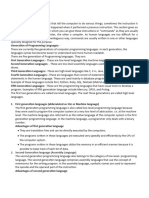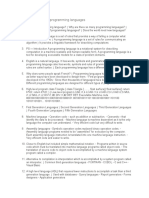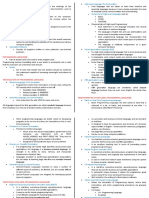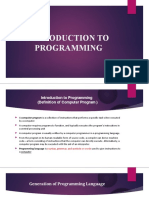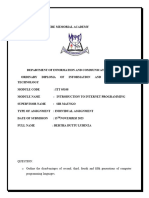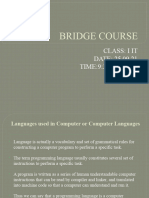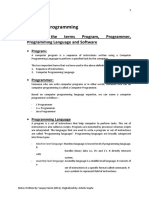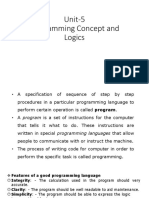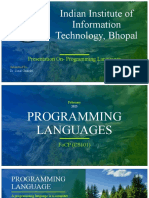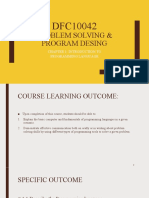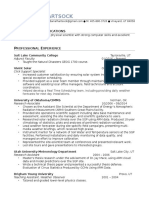Page 1 of 3
Programming Languages
Computer systems carry out their operations under the control of instructions called programs.
A program is a set of instructions written in programming language and designed to make a computer system
perform a series of specific tasks.
A programming language set of words or symbols that can be used to prepare computer programs
This process of preparing programs that can instruct the computer system is called computer programming.
People who program are called computer programmers.
Programming language may be categorized into five.
A. Machine code (first generation Languages)
B. Second generation languages/assembly languages
C. Third generation languages
D. Fourth generation languages
E. Fifth generation languages
a. Machine language (first generation language)
Were languages designed to instruct 1st generation computers.
Machine languages is a programming language based on binary codes i.e. data and instructions are written in
binary digits (O’s and I’s)
Features of machine language
1. Written in binary digits.
2. Do not need translations
3. Are complex languages to program coz the binary number system requires intensive understanding
that is cumbersome?
4. They are directly executed by the computer coz no time is wasted during translation.
5. They are machine specific i.e. are designed to run on a specific computer system. (Not portable)
6. They are procedural. The user must specify the desired results.
7. Every statement must have the corresponding machine code.
Advantages
1. Are executed very fast since no time wasted in translation
2. Have very high security. Difficult to alter since only professionals can read them.
Disadvantages
1. Time consuming when programming
2. Programs are normally prone to errors
3. Difficult to understand
4. Difficult to debug (remove errors)
(b) 2nd generation languages (Low level languages or Assembly language)
Were developed to overcome the set backs of machine languages.
Machine languages were complex and difficult to program, the 2 nd generation languages use symbolic codes
to represent operation.
Each symbol has corresponding binary digits.
Add represents addition
Sub represents subtraction
End represents end of task.
Features of 2nd generation languages
1. Requires translation
2. Are procedural i.e. user must specify the desired results and how to obtain the results.
3. Highly machine specific not portable
4. They use symbolic codes to represent information.
5. They are easy to memorize requiring less program time.
Advantages
1. Easier to use than machine languages
2. Easier to debug than machine languages
Prepared by Fred. --@2022 ICS 2175: INTRODUCTION TO Computer programming
� Page 2 of 3
3. Not as time consuming when programming as compared to machine language.
Disadvantages
1. Not readily executed since they require translation
2. Are machine dependent i.e. Not portable.
3. Always resulted in very long programs.
(c) Third generation languages
These languages are scientific in orientation
Can be grouped into three.
I. Scientific programming language were use to develop scientific application e.g. Fortran, Pascal.
II. Business languages – developing business operations e.g. COBOL
III. Multi purpose language – used for both scientific and business applications e.g. BASIC
Features Of High Level Languages
1. Highly portable- can be used in different machines.
2. Require translation – use English like statement, which need to be translated into machine
languages.
3. Are procedural – user only need to state how to obtain result.
4. Use symbolic codes – resembling ordinary English.
Advantages
1. Easy to learn coz they are English like (user friendly)
2. Machine independent i.e. portable
3. Take up less time during programming because are easy to understand.
4. Self documenting- because of the English likeness.
5. Easy to maintain because its easy to modify statement.
6. Have few errors during coding
Disadvantages
1. Executed more slowly because they require translation
2. Use computer resources less efficiently because they are machine independent.
(d) Fourth generation languages
Use English-like statements to access information
Designed to solve specific problems or develop specific application by enabling the user to specify
what he wants rather that step by step of getting what we want.
Are usually known as query language.
Are problem oriented i.e. are meant for solving a particular problem.
Features of 4th generation
1. Non – procedural that is user only need to solve the result and not how to obtain the results.
2. Have screen generations, which enables the user to format the screen for easy processing of data.
3. Have query languages that facilitate sharing of computer resources.
4. User friendly (reusability of codes)
5. Fault tolerant. Allow any mistakes made in data entry to be corrected with ease.
6. Application generator – allows a user to give a detailed explanation of what data lead to process.
E.g. oracle, spls structure query languages,
Advantages
1. User friendly
2. Increase programmers productivity by simplifying process
3. Encourage end user program encouraging application of IT in organization.
Disadvantages
1. Not suitable for complex work involving high volume of translation
2. Have specified format of procedures
Prepared by Fred. --@2022 ICS 2175: INTRODUCTION TO Computer programming
� Page 3 of 3
(e) Fifth generation
5th generation are considered to be the languages of the future.
Meant for experts system and artificial intelligence.
Characteristics Of Good Programming Language
1. Ability to omit ambiguous statement
2. Ability to express programs in readable form
3. Ability to express solution to problems in an application area
4. Ability to express such solutions as compactly as possible.
Factors To Consider When Selecting A Programming Language
1. Cost, development time and effort – 4th generation language have shorter development time that
machine languages. We must consider how long it will take to develop a program using a particular
programming language.
2. Compatibility with other programs as well as existing technology.
3. Level of support – e.g. documentation or manuals.
4. User experience – e.g. which programming language will users prefer?
5. User friendliness – the ease of learning and using
6. Availability and portability of a compiler.
7. Performance and efficiency
8. Purpose of the language – e.g. in a scientific area, one can’t go for COBOL.
9. Error checking and diagnostic facilities available i.e. debuggers.
Prepared by Fred. --@2022 ICS 2175: INTRODUCTION TO Computer programming



